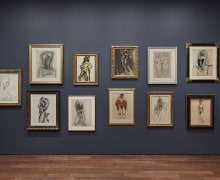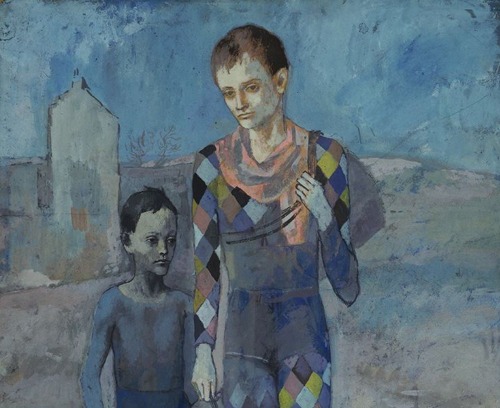

Bill Acquavella has been selling very expensive art for a very long time.
By James Tarmy
Acquavella Galleries’ current show of rarely seen, extremely high-quality drawings by Pablo Picasso has become a must-see for New York’s art world. Bloomberg Pursuits spoke to the gallery’s 84-year-old president, Bill Acquavella, about the Picasso market, the state of trophy art, and Lucian Freud’s gambling debts. The interview has been lightly edited and condensed for clarity. Picasso: Seven Decades of Drawing runs through December 3
First, congratulations on the show.
I’ve got seven decades of his work—86 pieces, starting from pre-cubism, even earlier. The Met lent us some work, the MoMA, Art Institute of Chicago. We borrowed from museums, but 90% of it comes from private collections, which means most people have never seen the work.
You’ve been selling Picassos nearly as long as Picasso was making them.
His market has become a brand, almost. You don’t have to explain to a new collector who Picasso is. You might have to explain who Kandinsky is, or who Mondrian is, or Pollock. But you don’t have to explain Picasso.
The world mostly hears about the art market through auction results. Are you familiar with recent, major transactions that happened privately?
People don’t realize it, but privately a lot of masterpieces change hands, there’s no question. But the auctions have the same amount, probably more now, because there aren’t many dealers dealing in these things at this point. So most come out at auction.
Why have dealers dropped out of the masterpiece market?
It’s hard to find them and hard to get them—it’s very capital intensive—you just don’t have a lot of work available. We have some. Because it’s more water going through fewer pipes, there aren’t many of us doing it. So I have the opportunity to get them from time to time.
But hasn’t the market always required a lot of capital? Famously, you went in with Sotheby’s on a $150 million deal in 1990 to buy the late art dealer Pierre Matisse’s inventory, which you then sold for $300 million.
It was so capital intensive. I went to Sotheby’s, to [then-owner] Al Taubman, and I said let’s buy this together, because I don’t have the money. More than not having the money, I didn’t have the back office to handle 4,000-plus items. So I convinced him to do it, and they sold some commercial paper and we raised the money. Most of the sales in that collection went to Japan. And America, but a lot went to Japan, it was an exciting time.
Let’s talk about the Macklowe collection, coming to sale at Sotheby’s on Monday.
I bet that Rothko could bring $100 million. Think of it this way: You can remake the money but you can’t remake the picture, OK? Any of this stuff, if someone is a real collector and they want a Twombly, then they have to buy this one, because they’re not going to find another very easily.
Sure, but it’s pretty thin air once you get to $50 million paintings.
For you or me maybe, it’s the money, but for the big collectors who can afford it, these sales are all opportunities. It doesn’t matter so much what the price is. I mean it does, but if you’re really interested in building a great collection for yourself you just go ahead and do it.
Talk about a high barrier to entry—if that’s the price of a “great” collection.
Art’s not for everybody, OK? You’ve got to be able to afford art. There’s no point saying you’re going to build a collection if you have no money. Well, if you’re a true collector, you can build a collection without money, but it might not be the paintings we’re talking about.
Meanwhile, the market for some of the biggest artists of the 20th century seems a little lackluster.
Impressionism and post-impressionism, it’s true, have slowed down. But the reason’s mostly thatthere’s no availability, and you can’t build a market. A new client comes in and he wants to decorate a house and build a collection—he doesn’t want to buy one painting a year. You have to go where you can at least find things. Emerging artists are a big area to collect because you can buy a picture a day.
Can you give me an example of markets that have taken a dip?
Odilon Redon is one. A very good artist who was quite popular in the 1970s and 1980s—now there’s no interest in him, although he’s a wonderful artist. If a great one comes up, it would probably bring money. And all those color field painters of the 1960s—they were the hottest thing you could buy. Morris Louis, Helen Frankenthaler, Jules Olitski. After that, the fashion for them kind of went away. They were good artists, and now they’re coming back. I’ve always believed the artist has to contribute to the development of art history to really have staying power. Some of those artists did contribute, and now they’re coming back.
Them and everyone else. Do you ever think prices have gotten unsustainably high?
Is it the art going up, or is it the money going down? You can also look at it that way. Look at what other things cost—look at what people pay for vacation houses or what they pay for airplanes and cars. I saw a guy driving a Bugatti. I asked my son, how much is that? And he said “$2.6 million.” Are you kidding? If people want to spend their money there’s a million ways to do it. When I started with Lucian Freud in 1992, his big pictures cost $600,000. When he died in 2011, those same pictures were bringing $30 million apiece.
Is it true when you signed him he had something like $5 million in gambling debts?
It was £2.7 million in gambling debts. He didn’t even tell me about it. We never signed anything, we just shook hands. I said, “Let’s try it for two years. I’ll buy everything you make for those two years, if it works for you, if it works for me, we’ll keep going.” And then when I started working with him, he said, “Well, I owe this.” What I did is, I was able to have Lucian do a portrait of the bookie’s two sons, and that reduced the swelling a little bit.
A bargain for the bookie, in retrospect.
He made out with a hell of a deal.